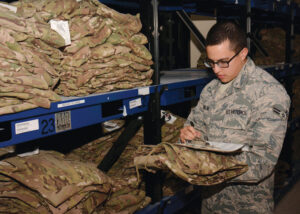As the United States enters the 9th year of economic recovery from the recession, the outlook for technical textiles is strong. In fact, 2018 may be the start of the most defining period for the industry since the introduction of man-made fibers in the 1960s opened tremendous opportunities in markets such as aerospace, military, medical and construction.
What’s happened? It’s not sudden. The industry usually tends to experience gains from evolutionary trends rather than specific market disruptors. There are several converging factors, though, which lead to the faster positive outlook:
- Gross Domestic Product (GDP) increased 2.3 percent in 2017 — compared with a 1.5 percent increase the previous year — and stable commodity pricing gave consumers spending confidence;
- Two of the largest consumers of technical textiles — military and infrastructure — are about to receive huge new government financial infusions;
- Pent up demand after years of cutbacks;
- Non-technical textile companies are paying attention to the industry such as Alphabet (Google) in its development of smart textile consumer applications; and
- U.S. trade policy is moving more towards bilateral rather than multilateral agreements which tend to allow more focus on protecting domestic sourcing.
The United States continues to see declines in textile manufacturing employment. The Bureau of Labor Statistics reports the 2017 job loss was 4,100 or 1.5 percent. What is notable is that imports are not considered to be a significant factor in the decline as has been the case in previous years. The biggest factor accounting for job loss is modernization and automated assemblies. It takes fewer people to operate a plant. It’s time to start thinking declining employment is not a sign of failure. Success should not be measured by how many are employed compared to 30 years ago.
The technical textiles industry is broad and diverse and almost impossible to define. In general, technical textiles represent the largest segment of the domestic textile industry’s output. Currently, about 42 percent of the wovens, knits and nonwovens are going into technical textile end-product segments. The largest markets are automotive, military/law enforcement, healthcare and construction.

Trade Issues
What a difference a couple of years can make. One of President Barack Obama’s legacy programs was the National Export Initiative (NEI), which was established with the hopes of greatly expanding U.S. exports, including new trade agreements. As part of the push, the passage of the Trade Promotion Authority (TPA) and Trade Preference Extension Act was observed, as well as the likely passage of the Trans-Pacific Partnership (TPP) agreement and its European counterpart Transatlantic Trade Investment Partnership (T-TIP).
The Trump administration, however, is operating under the mandate that reciprocity in trade implies that as we grant access to U.S. markets, the U.S. gains access to foreign markets. In his “2018 Trade Policy Agenda and 2017 Annual Report,” President Trump laid out his position that past and pending trade agreements leave U.S. workers and businesses at a disadvantage in global markets because other nations benefit from market-distorting practices, and these agreements prevents the United States from responding to changing market conditions.
The first act of the new administration was to withdraw the already negotiated TPP agreement from Congressional consideration. Further, the change in administrations, plus the unsettled business of the European Union (E.U.) dealing with Britain’s Exit from the European Union (BREXIT), has cooled interest in continuing T-TIP negotiations.
While TPP contained some concerns for the technical textiles industry such as illegal shipments passing through the participating countries, most issues for textiles addressed manufacturers in the apparel value chain. The Washington-based National Council of Textile Organizations (NCTO), the domestic textile industry’s lobbying organization, had successfully negotiated adding the “yarn forward” rule of origin into the TPP agreement in exchange for NCTO’s support of TPA.
T-TIP is more worrisome because of the passed TPA, which prevents Congress from making any changes once negotiations are finalized. Unlike TPP, T-TIP is a bilateral negotiation between the United States and the European Union, an organization representing the interests of its 27-nation members. The E.U.’s textile objective in T-TIP is to lift the restrictive criteria of the Berry Amendment and allowing its members access to source technical textile products to the U.S. military.
To be fair, the Obama administration had publicly opposed giving up the Berry Amendment; however, U.S. trade negotiators have a history of trading away the textile industry to gain concessions that protect other industries such as pharmaceutical, steel and automotive. Losing protection provided by the Berry Amendment would have a devastating impact on the U.S. technical textiles industry because the U.S. military has been a reliable market through periods of industry economic and trade challenges.
The United States may not be done with either T-TIP or TPP — now renamed the Comprehensive and Progressive Agreement for Trans-Pacific Partnership. T-TIP has merely been set aside; the talks have not ended. And President Trump has indicated he is open to pursuing a revised TPP agreement though it’s unclear what revisions he wants. Some 25 Republican Senators recently sent President Trump a letter urging him to get the United States involved again in the negotiations.
While T-TIP is sidelined at least for a while, a Canada-E.U. free trade agreement (FTA) went into effect September 2017. The agreement puts the United States at a disadvantage relative to Canada with a relaxed rule of origin for textiles and also the specific inclusion of reciprocal opportunities between the countries on government procurement. Going forward on trade, the Trump administration has stated its preference for bilateral rather than multinational agreements. It has set its sights on renegotiating the North American Free Trade Agreement (NAFTA) and possibly the Dominican Republic-Central America Free Trade Agreement (CAFTA-DR).
One positive factor as trade negotiations that affect the U.S. textile industry move along, is that Wilbur Ross is the secretary of the Department of Commerce (DOC). Until recently, Ross owned the Greensboro, N.C.-based multinational textile manufacturer International Textile Group (ITG).
The challenge in articulating the technical textiles industry’s positions in trade negotiations is that most of the industry’s end products are component parts of larger items such as cars and recreational items. They are not as easily identifiable as products in the apparel and home furnishings markets.

NAFTA Status
In the NAFTA negotiations, NCTO has focused on textile manufacturing issues that are predominantly apparel-oriented, but also may offer benefits to the technical textiles industry. The organization has identified four key points from the current agreement that should be reconsidered including:
- eliminating tariff preference levels (TPLs) on apparel, non-apparel sewn products, fabrics and yarns;
- requiring use of NAFTA-origin components beyond the “essential character” of the fabric — sewing thread, pocketing and narrow elastics for example;
- strengthening Buy American laws for the Department of Homeland Security (DHS) textiles and clothing by closing the Kissell Amendment loophole for Canada and Mexico; and
- strengthening customs enforcement.
But the key NAFTA renegotiating issue for the technical textiles industry isn’t with TPLs and probably not even yarn forward; it’s what could happen with the end products covered within the agreement, specifically in automotive manufacturing. The Trump administration is pursuing a tricky course because the automotive industry in Mexico is the largest export market for U.S. technical textiles.
In the current NAFTA agreement, approximately 62 percent of component parts in a vehicle made in North America must be from one of the three countries — Mexico, Canada or the United States. The Trump administration has proposed raising that threshold to 85 percent, of which half would have to come from the United States and the rest be divided equally between Canada and Mexico. Since textile products are found in numerous vehicle applications such as seating, headliners and airbags, changes to NAFTA could be a serious market disrupter with disastrous implications if Mexico doesn’t accept U.S. demands and pulls out of the agreement altogether to protect its growing automotive industry; or if auto makers themselves decide that new higher thresholds of U.S. components could make the vehicles more expensive and decide to push more production back overseas.
An intriguing aspect of the negotiations is that Mexico’s President Enrique Peña Nieto’s term ends this year and elections will be held in July. The likely winner at this point will be his party’s opponent, Andres Manuel Lopez Obrador. As strained as the relationship already is with Mexico, Lopez has promised to get even tougher on trade with President Trump. Canada and the United States also will hold elections in 2018, so it is probable that nothing will be accomplished until at least next year when the dust settles from the elections.
Impact Of Trade Agreements On Domestic Preference Laws
Trade agreements like NAFTA, as well as the World Trade Organization (WTO), can undermine the intent of other domestic preference laws. The Kissell Amendment enacted in 2009 is supposed to restrict DHS from using its funds to procure certain fibers, textiles, and clothing that are not grown, reprocessed, reused, or produced in the United States. A recent study by the General Accounting Office (GAO) found, however, that because of multiple trade agreement factors, foreign textile product procurement is prevalent by DHS. From September 2014 to June 2017, 58 percent of the $164.6 million of DHS textile items procured were foreign-sourced, including uniforms for Secret Service, Customs and Border Protection, and Immigration and Customs Enforcement agents.
As of Textile World’s press time, the Miscellaneous Tariff Bill, which has been approved by the U.S. House of Representatives, had not yet been passed by the Senate. The trade bill includes a correction for certain inputs that can affect Berry waivers.
Export Focus
Looking at exports, DOC’s International Trade Administration (ITA) has identified four sectors that it watches for technical textiles: specialty and industrial fabrics; medical textiles; protective apparel; and nonwovens.
ITA also ranked the top five countries for U.S. exports, which are:
- Mexico;
- Canada;
- China;
- Germany; and
- the United Kingdom.
Mexico accounts for almost 50 percent of the domestic technical textiles exported. Canada is the second largest with its demand coming from the oil and gas industry, construction and healthcare markets. China is a country to watch. Although it ranks a distant third after Canada, U.S. exports to the country have seen double-digit increases over the past few years.
It’s interesting to note, that according to latest China government statistics, the United States is considered the fourth largest region exporting technical textiles to China, after Japan, Taiwan and South Korea.









